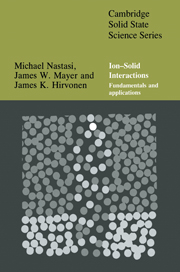Book contents
- Frontmatter
- Contents
- List of symbols
- Preface
- Chapter 1 General features and fundamental concepts
- Chapter 2 Interatomic potentials
- Chapter 3 Dynamics of binary elastic collisions
- Chapter 4 Cross-section
- Chapter 5 Ion stopping
- Chapter 6 Ion range and range distribution
- Chapter 7 Radiation damage and spikes
- Chapter 8 Ion–solid simulations and diffusion
- Chapter 9 Sputtering
- Chapter 10 Order–disorder and ion implantation metallurgy
- Chapter 11 Ion beam mixing
- Chapter 12 Phase transformations
- Chapter 13 Ion beam assisted deposition
- Chapter 14 Applications of ion beam processing techniques
- Chapter 15 Ion beam system features
- Appendix A Crystallography
- Appendix B Table of the elements
- Appendix C Density of states
- Appendix D Derivation of the Thomas–Fermi differential equation
- Appendix E Center-of-mass and laboratory scattering angles
- Appendix F Miedema's semi-empirical model for the enthalpy of formation in the liquid and solid states
- Appendix G Implantation metallurgy – study of equilibrium alloys
- Appendix H Physical constants, conversions and useful combinations
- Index
Chapter 11 - Ion beam mixing
Published online by Cambridge University Press: 27 January 2010
- Frontmatter
- Contents
- List of symbols
- Preface
- Chapter 1 General features and fundamental concepts
- Chapter 2 Interatomic potentials
- Chapter 3 Dynamics of binary elastic collisions
- Chapter 4 Cross-section
- Chapter 5 Ion stopping
- Chapter 6 Ion range and range distribution
- Chapter 7 Radiation damage and spikes
- Chapter 8 Ion–solid simulations and diffusion
- Chapter 9 Sputtering
- Chapter 10 Order–disorder and ion implantation metallurgy
- Chapter 11 Ion beam mixing
- Chapter 12 Phase transformations
- Chapter 13 Ion beam assisted deposition
- Chapter 14 Applications of ion beam processing techniques
- Chapter 15 Ion beam system features
- Appendix A Crystallography
- Appendix B Table of the elements
- Appendix C Density of states
- Appendix D Derivation of the Thomas–Fermi differential equation
- Appendix E Center-of-mass and laboratory scattering angles
- Appendix F Miedema's semi-empirical model for the enthalpy of formation in the liquid and solid states
- Appendix G Implantation metallurgy – study of equilibrium alloys
- Appendix H Physical constants, conversions and useful combinations
- Index
Summary
Introduction
Materials under ion irradiation undergo significant atomic rearrangement. The most obvious example of this phenomenon is the atomic intermixing and alloying that can occur at the interface separating two different materials during ion irradiation. This process is known as ion beam mixing. An early observation of the ion mixing phenomenon was made following the irradiation of a Si substrate coated with a thin Pd film. A reaction between Pd and Si was observed when the irradiating Ar ions had sufficient energy to penetrate the Pd/Si interface (van der Weg et al., 1974). This process is schematically displayed in Fig. 11.1 for a layer M on a substrate S for successively higher irradiation doses. Early in the irradiation, when ion tracks are well isolated, each incident ion initiates a collision cascade surrounding the ion track. Atoms within the cascade volume will be mobile and undergo rearrangement for a short period of time, resulting in an intermixed region near the interface. At this stage of the ion mixing process, the interfacial reaction is considered to be composed of many localized volumes of reaction (Fig. 11.1(a)). As the irradiation dose is increased, overlap of localized regions occurs (Fig. 11.1(b)), and for higher doses a continuous reacted layer is formed at the interface (Fig. 11.1(c)).
A major driving force in the development of the ion beam mixing process is its ability to produce ion-modified materials with higher solute concentrations at lower irradiation doses than can be achieved with conventional high-dose implantation techniques.
- Type
- Chapter
- Information
- Ion-Solid InteractionsFundamentals and Applications, pp. 295 - 331Publisher: Cambridge University PressPrint publication year: 1996
- 3
- Cited by



